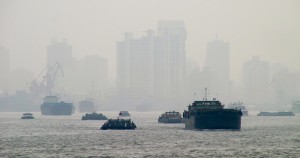“Foreign Correspondents as They Live and Breathe,” (New York Times, March 30, 2017) reports on the still deadly air pollution in China:
Ian Johnson, a China correspondent, took out his phone to check Air Matters, an app that measures air quality based on the Environmental Protection Agency’s Air Quality Index, which scores the air from 0 to 500. Over 300 and the air is “hazardous.”
The NYT post says Trump Administration actions on coal power CO2 emissions will hurt efforts to reduce pollution worldwide:
Now efforts to dial back air pollution worldwide are likely to take a hit: On Tuesday, less than a week after rolling back fuel-economy standards for the auto industry, President Trump announced an executive order reversing the rest of the Obama administration’s climate plan. If carried through, the order — which lifts American limits on carbon dioxide emissions from coal-fired power plants, the largest contributor of particulate pollution…
Carbon dioxide and particulates are both released from coal-fired power plants and not from solar, wind, and hydropower. Power plants fired by natural gas power don’t emit particulates and release far less carbon dioxide than burning coal (though studies show some methane is released by leaks in natural gas drilling and transportation).
Technologies that reduce CO2 emissions from burning coal are different and more expensive than technologies that reduce particulate emissions. People are suffering and dying now from particulate emissions from coal in Beijing and around China, but not suffering or dying from CO2 emissions.
“Beijing’s deadly air pollution has forced it to close all of its large coal-power plants,” (Quartz, March 22, 2017) notes that Beijing has closed it’s coal power plants, but still imports electricity from nearby provinces that burn huge amounts of coal:
…in 2013 the city’s administration swore to stop using coal in the large power-plants that supply electricity to the capital and its 21 million inhabitants. By 2015, three of its four coal-fired power plants had been shut down and have switched to natural gas. On Saturday (Mar. 18), the Huaneng Beijing Thermal Power Plant, which produced 845 MW of power—more than a tenth of the power created by all power plants near Beijing—was closed down, too. Its transition to burning natural gas will start soon.
But the city’s hunger for power means it’s unlikely to run on coal-free energy any time soon, or that regular blue-skies will become a reality. Beijing still gets a chunk of its power from neighboring provinces such as Hebei and Inner Mongolia, where huge coal-power plants are in operation.
The Quartz article reports that coal is “dirty” power:
Coal is the dirtiest of fossil fuels. Per kilogram, it produces the least amount of energy and the most amount of pollution (as carbon dioxide, particulate matter, nitrogen oxides, and sulfur oxides). And China consumes a lot of it.
But while particulate, nitrogen oxides (NOx) and sulfur oxides (SOx) are pollutants, carbon dioxide (CO2) is not a pollutant. CO2 contributes to global warming. Burning coal and other fossil fuels adds CO2 to the atmosphere, which is now .0004 CO2 (.04 percent):
The Earth’s atmosphere is 78 percent nitrogen, 21 percent oxygen and 1 percent other gases, including about 0.04 percent carbon dioxide.
 Carbon dioxide in the atmosphere has risen from .00028 (.028) at the beginning of the industrial revolution due mostly to burning of fossil fuels in developing and developed countries. Particulate pollution from coal burning in China today causes health problems similar to pollution from the “dark satanic mills” during England’s Industrial Revolution, that William Blake wrote of.
Carbon dioxide in the atmosphere has risen from .00028 (.028) at the beginning of the industrial revolution due mostly to burning of fossil fuels in developing and developed countries. Particulate pollution from coal burning in China today causes health problems similar to pollution from the “dark satanic mills” during England’s Industrial Revolution, that William Blake wrote of.
Over a century later, pollution from coal was still killing across the United Kingdom. The Great Smog of 1952, also called the Big Smoke killed some 4,000 people, and is discussed in “Everything to Know About the Great Smog of 1952, as Seen on The Crown,” (Time, November 4, 2016)
The Big Smoke developed in London on Dec. 5, 1952, triggered by a period of cold weather collecting airborne pollutants, mainly from the coal fires that were used to heat homes at the time, which formed a thick layer of smog over the city.
According to the United Kingdom’s public weather service, it was so thick you couldn’t see from one side of the street to the other. In one East London area, it was reported to be so thick people could not see their feet.
See also “60 years since the great smog of London – in pictures,” (The Guardian, December 5, 2012).
Connections between the 1952 London to China today, “Research On Chinese Haze Helps Crack Mystery Of London’s Deadly 1952 Fog,” (NPR/the two-way, November 23, 2016):
A team of atmospheric scientists researching pollution in China say they’ve cracked a 60-year-old mystery — with research that explains not only the haze over Beijing, but also the remarkably toxic Great Smog of London from 1952.
By examining conditions in China and experimenting in a lab, the scientists suggest that a combination of weather patterns and chemistry could have caused London’s fog to turn into a haze of concentrated sulfuric acid.
The article describes the research in more detail, and concludes:
“London fog only had to do with coal burning — it is relatively easy to solve the problem,” Zhang says. “In Beijing or any other cities in China, you have coal burning, traffic emissions, agriculture. It’s very complicated … it’s very, very difficult [to solve].”
And earlier post, “For Still-Poor China, Coal Pollution from Home Heating,” focuses on China coal burning for heat, and the heavy pollution consequences. This earlier post highlights a key article: “Beijing’s Plan for Cleaner Heat Leaves Villagers Cold,” (WSJ, Jan. 25, 2017) which reports the continued problem of burning coal for home heating in communities near Beijing.
Chinese government policies that try to reduce CO2 emissions from burning coal rather than reducing particulate emissions, raise electricity costs, which results in more Chinese people burning coal at home instead of drawing electricity from the grid.

